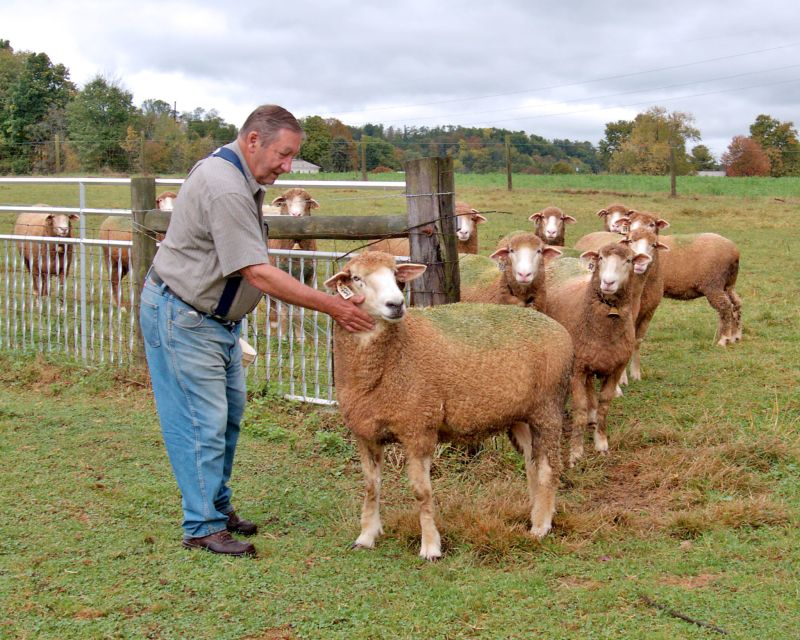For Winesburg retiree, selective breeding is the key to a successful flock
For James White, who runs a small farm near Winesburg, efficiency is the key to turning a profit. White is a retiree who used to raise cattle, but these days sheep are the animal of choice on his 14-acre farm.
Specifically Columbian sheep tend to be White’s favorite, though he is starting to breed in Polypay bloodlines to improve his breeding stock. “Columbians just get a bit bigger, leggier,” White said when asked about his breed of choice.
On White’s farm breeding is done so lambing happens over the winter.
“I shoot for November, December and January,” White said, “winter lambing so that they can go to market on time. It used to be that if you didn’t sell your lamb by June first, you may as well forget about it because the price dropped drastically. Right now that has kind of leveled off. The prices might go a little lower, but normally they stay fairly stable.”
By mid-summer when White goes to sell his lambs, he expects them to be at least 110 pounds. “We keep ours on a high-grain ration so that I can get a 110-pound lamb in 110 days,” he said.
The extraordinarily fast growth rate of these lambs is not the only factor that makes White’s farm efficient. Though Columbians are a wool breed that requires shearing, White hires this task out to make life a bit easier.
“The wool takes care of the price of shearing, but you don’t make anything on the wool,” White said. “It’s just to keep the sheep clean.”
Another thing that makes White’s farm operate smoothly is his selective-breeding program. He keeps careful records on each of his ewes, selling those that don’t make the cut. Most importantly White selects for mothering instinct.
Among Columbian sheep, ewes sometimes reject their lambs. After years of choosing breeding stock from among the best mothers, White said that these days he faces very few issues with ewes that won’t accept their lambs.
White also selects for factors such as age of first lambing, the ability to regularly produce twins and parasite resistance. His entire program is designed to produce larger lambs faster, vigorously healthy lambs that require a bit less upkeep than sheep that display fewer resistances. Worming for example can become a major expense, and frequent worming in and of itself can produce parasite populations that are difficult to manage.
“I worm less frequently than before,” White said. “I used to worm faithfully twice per year, but the internal parasites are becoming more resistant to the wormers. We’re worming so frequently that the parasites that don’t get hit with the wormer survive and go on to have more resistance.”
Between reduced worming frequency and selecting ewes that have increased resistance to internal parasites, White is both cutting costs on his farm and helping to combat the rising problem of wormer-resistant pests.
Where White’s efficiency really shines through is during lambing season itself. He has carefully selected for ewes that routinely produce twins.
“I get a 180-percent lamb crop,” White said. “So that is almost two lambs per ewe.”
Compared to cattle, that translates to more money made per acre.
“It’s always been a rule of thumb that five ewes equals one cow,” White said. For cattle, farmers generally estimate needing up to two acres of pasture per cow-calf pair, whereas five or more ewes can be pastured on one acre of good pasture. In other words, for every two acres a farmer could produce either one feeder calf or up to 20 lambs, provided that his or her ewes produce twins reliably.
At sale barn prices, sheep are bringing more dollars per pound and thus more dollars per acre. “Lambs are right around $2 per pound, whereas cattle, good feeders, are going to be maybe $1.10 per pound,” White said.
For these reasons and others, the lamb market in Holmes and Wayne counties is rapidly outpacing other forms of livestock. In fact, because of the rising interest in this market, the Ohio Sheep Improvement Association has been holding regular meetings at the Mt. Hope Event Center.
For those who would like to network with local breeders or learn more about raising lamb on both small and large scales, the next meeting, which is free to attend, will be held on Oct. 17 at 6:30 p.m.

